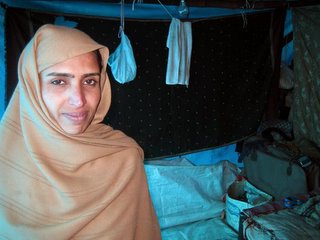By Katie Roland, Metro Marketing
& Communications Director for New York
I awoke this morning at 3 a.m., feeling icy-cold in my sleeping bag. Despite the five layers of clothing (literally!), the sub-zero sleeping bag, and the two thick blankets I used, I was still shivering. Continued below

A young Pakistani girl at one of World Vision’s Child Friendly Spaces in Balakot sports a New York Yankees baseball cap.

A tent village in Balakot.

Arslan lost both parents to the October 8 earthquake and is now attending programs at World Vision’s Child Friendly Space, located near his tent village.

The interior of a tent in a typical survivor village.

Saique is the village organizer at one of the tent villages in Balakot.
Amber and I joined the 1.9 million people in the Pakistan who are estimated to be living in 300,000 tents in earthquake affected areas when we decided to camp out in tents in Balakot. By most standards here, our sleeping conditions were posh. In addition to our cold-weather gear, the people who hosted us (true to Pakistani hospitality) provided us with their most comfortable surroundings: a winterized tent and a kerosene heater.
For safety reasons, we turned the kerosene heaters off before we went to sleep, enabling us to experience a very small piece of what life is like in these camps. As I lay awake in the early morning hours, my thoughts darted between the hacking coughs and barking dogs that echoed throughout the camp, to the hundreds of thousands of people who face these –2 degrees (Celsius) nights on a regular basis. These people do not have the luxury of “bucking up for a few hours” until they return home; rather, they need to figure out how they will survive the next few weeks and months of the harsh Pakistan winter.
I thought of all the children I had seen running around the camps earlier in the week and wondered how they were sleeping. Did they have anything but their thin shirts and skimpy sweaters to protect them from the freezing cold? Were they at least cozy in their tents with their families? Or were they among the hundreds of children who lost parents and siblings to the quake?
When the sun finally rose, I was able to walk around the camp and talk to people. I met a shy young boy named Arslan who lost both his parents in the quake. Arslan was dressed in a thin blue button down shirt and cotton sweater. He was wearing a baseball hat and had a striped scarf tied around his head for warmth.
When the earthquake hit, Arslan’s parents were cutting grass on the side of a a mountain when a landslide overtook them. Arslan was not allowed to look at their bodies because they were too disfigured. Home, family, and an entire village is a lot to lose at such a young age, and being left to grieve by himself would probably have been more than Arslan (or anyone) could bear.
Fortunately, his grandparents began to care for Arslan, and they brought him to the programs at World Vision’s Child Friendly Space, a place where children can play, draw, learn, and begin to express their emotions as they heal from the trauma of the quake. When he first arrived, he did not want to play with the other children. But, in taking time to interact with World Vision’s staff, and to express himself through drawing and games, he eventually became comfortable enough to participate in group activities.
Adjacent to both the school grounds where we met Arslan, and the tent village where we stayed, is another tent village. This village is comprised of a row of approximately 20 tents spaced one foot apart. We wandered through this area and met Saique, the village organizer. As village organizer, Saique makes sure the tents are kept clean. She also ensures sick children are taken to the hospital and that the village is free of sanitation issues.
As we walked along the row of tents, I asked Saique if she would be willing to show me inside. We chose the closest 10 x 8 foot tent. As we entered the tiny space, I asked Saique how many people slept in there and was shocked to hear the answer: 10!
To date, World Vision has distributed more than 7,000 tents to communities like Saique’s. We have also distributed more than 1,000 shelter kits (corrugated galvanized iron, wire, and wire cutters); nearly 3,000 rehabilitation kits (shovel, pick ax, work gloves and other basic tools); and 6,000 winterization kits (quilts, plastic sheeting, rope and mattress) to affected families in the region.
In addition, World Vision has established 15 Child Friendly Spaces throughout the earthquake region to help meet the emotional and physical needs of children like Arslan. Though Arslan may have a long way to go to recover from the trauma of this earthquake, World Vision is committed to helping Arslan and children like him, one life at a time.

No comments:
Post a Comment